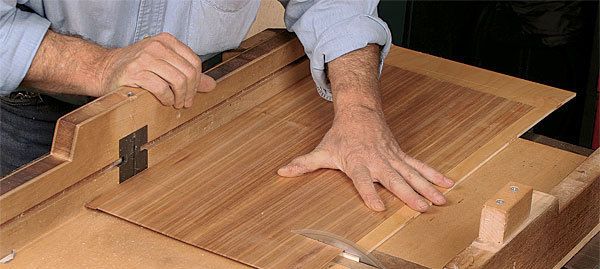Shop-Sawn Veneers Make Better Furniture
Wrap one beautiful board around an entire piece
Synopsis: David Welter and the students at College of the Redwoods don’t work with commercially available veneer; they prefer to saw their own. The reason? Shop-sawn veneers are thicker and more forgiving, and they make it easier to perfectly match all the wood in a particular project. Learn how to choose the right blade and resaw veneers of a consistent thickness, how to arrange veneer leaves for the best appearance, and how to glue up veneer for the best results. You’ll also learn two methods for applying edge-banding.
From Fine Woodworking #224
The main reason for using veneer is the same now as in Tutankhamun’s time: Veneering makes it much easier to cover a large area with very attractive or rare wood.
Used with man-made sheet goods as a substrate, veneer also minimizes the construction difficulties posed by solid wood, which moves with moisture changes. These days, there are veneer options that weren’t available when the pharaohs reigned, commercially cut veneers as well as shop-sawn. However, I only work with veneers I resaw myself at the bandsaw. And that’s what we teach at College of the Redwoods, in the cabinetmaking program founded by James Krenov.
Commercial veneers are available in thicknesses from 1⁄32 in. to 1⁄60 in., but the slightest misuse of furniture with these thin veneers can cause damage that requires a repair with the same vulnerable material. And it is rare that you’ll be able to perfectly match commercial veneers to the solid wood you’ll need for the other parts of a furniture project.
In stark contrast, shop-sawn veneer, described by Krenov as “real,” with a finished thickness of 1⁄16 in. to 3⁄32 in., can better withstand everyday use. And if the veneer is damaged, it is thick enough to sand or even plane, restoring the surface. Also, you can cut veneer from the same boards you use for solid wood, providing harmony throughout a project. Furniture made this way stands out from the arranged marriages of commercial veneer and solid wood. And because shop-sawn veneer is thicker, it’s easier to work with and doesn’t bubble as much as commercial veneer during pressing.
Successfully sawing and using your own veneers isn’t difficult. The keys are careful bandsaw setup, thoughtful layout, and a few edge-banding tips.
No method of ripping or resawing is better than a bandsaw. And a few minutes of careful setup will yield great resawing results without great risk.
The first thing to consider is the blade. A resaw blade needs deep gullets that can eject all of the sawdust that these tall cuts generate. I suggest a 3 tpi (teeth per inch) blade at least 1⁄2 in. wide. For dedicated resawing in widths greater than 6 in., a 11⁄2 tpi, 1-in.-wide blade reduces the effort needed to feed the stock and has more room to clear waste from the kerf.
Even if you have the blade set up just right, you might have to negotiate for drift, the tendency for the stock to wander away from the fence or for the blade to cut a wavy line. The solution is easy: Just angle the fence to match the blade’s natural cutting angle.
For the full article, download the PDF below.
Fine Woodworking Recommended Products

Bahco 6-Inch Card Scraper

Whiteside 9500 Solid Brass Router Inlay Router Bit Set























Log in or create an account to post a comment.
Sign up Log in